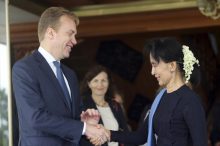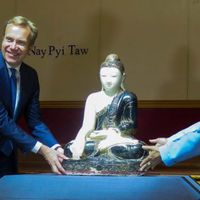Norway Returns Antique Buddha Sculpture to Myanmar

 As reported in several international media in the last few days, on 6 July the Norwegian Minister of Foreign Affairs, Børge Brende, formally returned a Buddha sculpture at the National Museum of Myanmar, Nay Pyi Taw, an ASEMUS member. The sculpture had been illicitly imported to Norway in 2011 via Thailand.
The alabaster statue depicts Buddha in the mudra of ‘earth witness’ (bhūmisparśa), one of the most common iconic representations of Buddha images in Myanmar. Its tumultuous story dates back to 2011 when the Norwegian Customs identified and prevented the illegal import of this cultural artefact. The Norwegian prosecutor confiscated the statue and, after years of research, the statue was identified by experts as originating from the Mandalay region in Myanmar and estimated to be between 150 and 200 years old. Hence, as a protected cultural object, the procedure for the return to its country of origin was initiated by the Government of Norway.
Recalling that both states are parties to the UNESCO 1970 Convention on the Means of Prohibiting and Preventing the Illicit Import, Export and Transfer of Ownership of Cultural Property, and bearing in mind the good relations based on mutual trust, representatives of the Governments of Norway and Myanmar, met at UNESCO in Paris on 16 January 2017 to formalise the statue’s return. According to UNESCO, the process conducted by Norwegian authorities to return the Buddha statue, illustrates a best practice for return of cultural property. Norway hindered the illegal import of the statue and engaged specialists to find its country of origin, thus securing a successful return to its country of origin, Myanmar.
The return of the Buddha statue furthermore marks an important step in the cultural cooperation between Myanmar and Norwegian authorities, with international counterparts, in regards to the global efforts to safeguard cultural heritage, and to curb illicit trafficking. Speaking at the formal ceremony where the sculpture was returned, the Norwegian Minister of Foreign Affairs hoped that this step would 'set an example for others to follow' and urged all countries to strengthen their efforts to protect and return cultural objects.
From 2016 and until its repatriation, the Buddha statue remained on display at The Museum of Cultural History in Oslo, where its presentation aimed to raise public awareness about illicit trafficking of cultural artefacts. Upon its return home, the Buddha statue will be put on display at the National Museum in Nay Pyi Taw.
Further reading:
As reported in several international media in the last few days, on 6 July the Norwegian Minister of Foreign Affairs, Børge Brende, formally returned a Buddha sculpture at the National Museum of Myanmar, Nay Pyi Taw, an ASEMUS member. The sculpture had been illicitly imported to Norway in 2011 via Thailand.
The alabaster statue depicts Buddha in the mudra of ‘earth witness’ (bhūmisparśa), one of the most common iconic representations of Buddha images in Myanmar. Its tumultuous story dates back to 2011 when the Norwegian Customs identified and prevented the illegal import of this cultural artefact. The Norwegian prosecutor confiscated the statue and, after years of research, the statue was identified by experts as originating from the Mandalay region in Myanmar and estimated to be between 150 and 200 years old. Hence, as a protected cultural object, the procedure for the return to its country of origin was initiated by the Government of Norway.
Recalling that both states are parties to the UNESCO 1970 Convention on the Means of Prohibiting and Preventing the Illicit Import, Export and Transfer of Ownership of Cultural Property, and bearing in mind the good relations based on mutual trust, representatives of the Governments of Norway and Myanmar, met at UNESCO in Paris on 16 January 2017 to formalise the statue’s return. According to UNESCO, the process conducted by Norwegian authorities to return the Buddha statue, illustrates a best practice for return of cultural property. Norway hindered the illegal import of the statue and engaged specialists to find its country of origin, thus securing a successful return to its country of origin, Myanmar.
The return of the Buddha statue furthermore marks an important step in the cultural cooperation between Myanmar and Norwegian authorities, with international counterparts, in regards to the global efforts to safeguard cultural heritage, and to curb illicit trafficking. Speaking at the formal ceremony where the sculpture was returned, the Norwegian Minister of Foreign Affairs hoped that this step would 'set an example for others to follow' and urged all countries to strengthen their efforts to protect and return cultural objects.
From 2016 and until its repatriation, the Buddha statue remained on display at The Museum of Cultural History in Oslo, where its presentation aimed to raise public awareness about illicit trafficking of cultural artefacts. Upon its return home, the Buddha statue will be put on display at the National Museum in Nay Pyi Taw.
Further reading:
- News story from Mizzima: http://www.mizzima.com/news-domestic/norway-returns-buddha-statue-protect-myanmar%E2%80%99s-national-cultural-heritage
- Press release by the Norwegian Ministry of Foreign Affairs: https://www.regjeringen.no/en/aktuelt/artefact-myanmar/id2564264/
Pictured above: Ministers of Foreign Affairs of Myanmar, Aung San Suu Kyi, and Norway, Børge Brende, during the latter's official visit to Myanmar ((c) Associated Press, Aung Shinee Oo); and picture of the returned Buddha sculpture ((c) Museum of Cultural History, University of Oslo, Ellen C. Holte)
Similar content
posted on
19 Jul 2017

